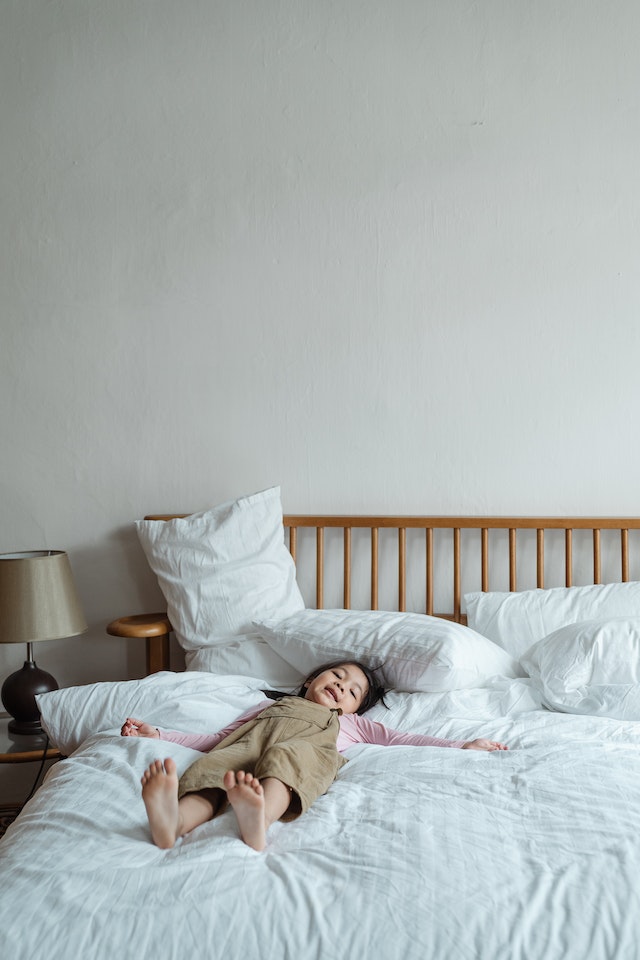Size of Full Bed, also known as a double bed, is a versatile size that falls between a twin and a queen-sized bed. Full beds are commonly found in various settings, from guest rooms to young adult’s bedrooms. In this article, we will delve into the dimensions and various aspects of a full-sized bed.
Contents
Dimensions
The standard dimensions of a full bed are 54 inches (137 cm) in width and 75 inches (191 cm) in length. This size can comfortably sleep two smaller adults or a single person with room to spare.
Variations in Size
In some cases, a full bed may be referred to as a ‘double bed.’ While the terms are used interchangeably in the United States, the size may differ slightly in other countries. In the UK, for instance, a standard double bed measures 53 inches (135 cm) by 75 inches (190 cm).
Who is it Ideal For?
Full beds are perfect for:
- Single adults who want more space than a twin bed offers.
- Couples with limited bedroom space.
- Teenagers transitioning from a twin bed.
- Guest rooms where space-saving is a priority.
Comparison with Other Sizes
- Twin Bed: Typically 39 inches (99 cm) wide and 75 inches (191 cm) long.
- Queen Bed: Generally 60 inches (152 cm) wide and 80 inches (203 cm) long.
- King Bed: Usually 76 inches (193 cm) wide and 80 inches (203 cm) long.
Bedding Sizes for Full Beds
When buying bedding for a full bed, the standard sizes are as follows:
- Flat Sheet: 81 inches (206 cm) wide and 96 inches (244 cm) long.
- Fitted Sheet: 54 inches (137 cm) wide and 75 inches (191 cm) long.
- Comforter: Around 80 inches (204 cm) wide and 86 inches (218 cm) long.
- Pillowcases: Standard/Queen, which measures 20 inches (51 cm) wide and 30 inches (76 cm) long.
Advantages of a Full Bed
- Space-saving: Full beds provide ample sleep space for single adults while conserving room space.
- Cost-effective: Full beds and their bedding are typically less expensive than queen or king sizes.
- Versatility: Suitable for single adults, couples, and guest rooms alike.
Disadvantages of a Full Bed
- Limited space for couples: It might feel cramped for two adults, especially if they prefer more sleeping space.
- Length: For taller individuals, the 75-inch length might be insufficient, causing discomfort.
Tips for Buying a Full Bed
- Measure Your Room: Before purchasing a full bed, ensure it will comfortably fit in your room with space for other furniture and walking.
- Consider Your Height: If you are tall, the length of a full bed might not be enough. In this case, a queen or king-size bed may be more appropriate.
- Assess Your Sleeping Habits: If you tend to move a lot while sleeping, a larger bed may be a better option.
A full bed, or double bed, is a versatile option that provides more width than a twin bed and takes up less space than a queen or king. It’s an excellent choice for single adults, smaller rooms, or guest spaces. However, couples or taller individuals might find it less comfortable due to its more compact dimensions. Before purchasing, it’s essential to measure your space, consider your height and sleeping habits, and assess your need for roominess during sleep.
A Chart Table size of full bed
Below is a chart that summarizes the dimensions of a full bed, along with comparisons to other common bed sizes, all measured in both inches and centimeters? This chart includes the dimensions for the mattress itself, as well as standard bedding sizes associated with each type of bed.
Please note that these dimensions are based on standard sizes and might vary slightly by brand or country. Always check the specific measurements on the product label when purchasing a mattress or bedding.
This chart should help you visualize the differences between a full bed and other common sizes, as well as guide you when you are shopping for sheets, comforters, and pillowcases for a full bed.
Example of the size of full bed
Below is a practical example of the size of a full bed, demonstrating its dimensions and considering how it might fit into various living situations:
Example: The Full Bed in a Small Apartment Bedroom
Room Dimensions:
The bedroom in a small urban apartment measures 10 feet by 12 feet (120 inches by 144 inches or 305 cm by 366 cm).
Bed Dimensions:
The full bed being considered for this room measures 54 inches wide and 75 inches long (137 cm by 191 cm).
Analysis:
Space Utilization:
Placing the full bed along the 10-foot wall (120 inches), there will be 33 inches (83 cm) of space remaining. This space could accommodate a nightstand and a small dresser or leave a comfortable walkway.
Room for Other Furniture:
With the bed’s length of 75 inches along the 12-foot wall (144 inches), there will be 69 inches (175 cm) remaining. This space is more than enough for additional furniture such as a desk, a bookshelf, or a dressing table.
Comfort for Occupants:
For a single adult, this full bed provides ample space to sleep comfortably, with extra width for changing sleep positions freely.
For a couple, this bed might be a bit snug, as each person gets 27 inches (68.5 cm) of width, which is less than a twin bed per person. However, it can be a cozy option for couples who don’t mind sleeping close to each other.
Visual and Aesthetic Aspect:
In a room of this size, a full bed will be a significant piece of furniture but won’t overpower the room. There will still be ample floor space visible, making the room appear organized and spacious.
Ease of Moving and Setup:
Due to its moderate size, a full bed is relatively easy to move and set up, even in tighter spaces like small apartments. It is big enough for comfort but not so large that it is difficult to maneuver through hallways and doors.
In this example, the full bed proves to be a very practical choice for a small apartment bedroom. It allows for comfortable sleeping space while leaving room for additional furniture and movement. For a single occupant, it’s spacious, and for a couple, it’s cozy without taking up too much valuable floor space in the apartment.
This example illustrates how a full bed can be a fantastic option for those with limited space, offering a balance between comfort and room efficiency.
Frequently Asked Questions about size of full bed
Here is a list of frequently asked questions (FAQs) about the size of a full bed, along with their answers:
Q1: Is a full bed big enough for two people?
A: A full bed, which measures 54 inches by 75 inches, can accommodate two people, but it may feel cramped compared to larger options. Each person would have about 27 inches of space, which is less than the width of a twin bed per person.
Q2: Is a full bed the same as a double bed?
A: Yes, in the United States, the terms “full bed” and “double bed” are often used interchangeably. They typically refer to a mattress that is 54 inches wide and 75 inches long.
Q3: What is the difference between a full bed and a queen bed?
A: A full bed measures 54 inches by 75 inches, while a queen bed is larger, measuring 60 inches by 80 inches. This means a queen bed provides more width and length, making it more comfortable for two people or for taller individuals.
Q4: Is a full-size bed suitable for a tall person?
A: A full-size bed is 75 inches long, which might be insufficient for someone who is very tall. Individuals over 6 feet tall may find a queen or king-size bed more comfortable due to the extra length.
Q5: Can I use queen-sized sheets on a full bed?
A: While you can physically put queen-sized sheets on a full bed, they might not fit snugly since queen sheets are larger. The excess material may bunch up and cause discomfort while sleeping.
Q6: Are full size bed frames significantly cheaper than queen size frames?
A: Full size bed frames are generally less expensive than queen size frames, but the difference in price can vary widely depending on the material, brand, and design.
Q7: What age group is a full bed suitable for?
A: A full bed is versatile and suitable for various age groups, including teenagers, young adults, and older adults. It’s a popular choice for teenagers transitioning from a twin bed and for single adults.
Q8: Can two full beds make a king?
A: Pushing two full beds together will not equal a king-size bed. Two full beds together would measure 108 inches wide, which is significantly wider than a standard king-size bed (76 inches).
Q9: Is it hard to find bedding for a full bed?
A: No, full-size bedding is widely available and is a standard size carried by most retailers that sell bed linens.
Q10: Will a full bed fit in a small bedroom?
A: A full bed is often a great choice for a small bedroom. It is larger than a twin but smaller than a queen, making it a good compromise for single adults or tight spaces. Always measure your room before purchasing to ensure a good fit.
Remember that the answers to some of these questions might vary slightly based on the specific product or region. Always check product specifications when purchasing a new mattress or bed frame.

Summary
The full bed, also known as a double bed, strikes a balance between space and comfort, making it a versatile and practical choice for a variety of living situations. Measuring 54 inches in width and 75 inches in length (137 cm by 191 cm), it offers a significantly wider sleeping area than a twin bed, yet takes up less room than a queen or king-sized bed. Here are some key takeaways:
- Ideal for Single Sleepers: A full bed is spacious for single adults, providing plenty of room to stretch and move during sleep. It is often the go-to upgrade for teenagers and young adults moving beyond the confines of a twin bed.
- Cozy for Couples: While it can comfortably accommodate two average-sized adults, couples may find it a bit snug compared to larger options. However, it is a cozy option for couples who are comfortable sleeping close to each other.
- Space Efficiency: For small bedrooms, guest rooms, or studio apartments where space is premium, a full bed is often the perfect choice. It allows for a comfortable sleep setting without overwhelming the room’s available space.
- Cost-Effective: Generally, full beds and their associated bedding are less expensive than their queen and king counterparts. This makes them a budget-friendly option for people looking to save on initial costs.
- Widely Available Bedding: Finding bedding for a full bed is a breeze, as it is a standard size. Retailers offer a wide variety of options in terms of sheets, comforters, and mattress protectors for full beds.
- Considerations for Tall Individuals: For those over 6 feet tall, a full bed may feel a bit short. In such cases, looking towards a queen or king bed, which is typically 80 inches in length, maybe a wise decision.
- Adaptable to Various Life Stages and Living Situations: From young adults in their first apartments to older adults looking to downsize, the full bed remains a steadfast and sensible option.
Full size bed dimensions are the size of full bed is a stellar choice for those who are seeking more space than a twin offers without the larger footprint of a queen or king. Whether for a single adult, a teenager, a guest room, or a couple who prefers close quarters, the full bed’s size offers comfort, versatility, and practicality. It is a timeless choice that continues to meet the needs of various individuals and living spaces.







